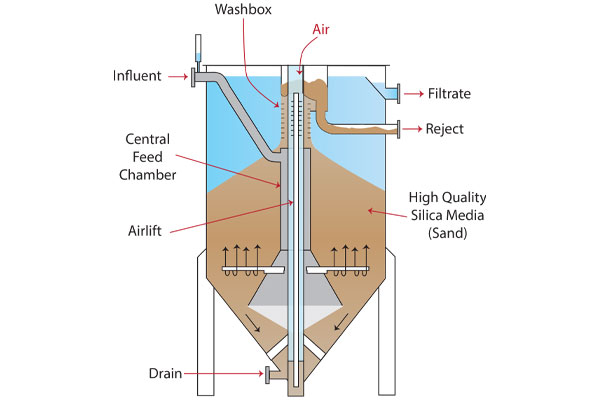Choose a different country or region to see the content specific to your location
Select Your Country/Region
Current Region:
 Global (EN)
Global (EN)
Choose a different country or region to see the content specific to your location
Current Region:
 Global (EN)
Global (EN)
How can we help you?
Backwashing is a process that is used in water and wastewater treatment to pump water backward through filter media, which includes anything placed in a filter that changes the quality of water flowing through it. This process sometimes involves the intermittent use of compressed air and is a form of preventative maintenance so filter media can be reused.
Semicontinuous and continuous are the two types of backwashing. Semicontinuous backwashing takes place by pumping clarified water below the sand filter and sucking it out from the top with a separate pump. Backwash water is discharged into the main distribution inlet header for reprocessing. Air from the blower is used in a semicontinuous pulsed-bed filter. When the suspended solids in the effluent cease to filter to an acceptable level of the head, pressure begins to increase, and backwashing begins.
Continuous backwashing is an up-flow, moving bed filter that is constructed with various media depths for different applications and configurations. Raw water enters near the bottom of the tank, and suspended solids are filtered out as the raw water flows up through the media bed. As the filtrate reaches the top of the filter, it passes over the effluent weir and is discharged. A portion of the filtrate is diverted through the sand washer and used for cleaning and transferring the waste solids.
Hoffman & Lamson is the industry’s global leading specialist of engineered products ensuring reliable, quality, and cost-effective solutions for water and wastewater applications.
Air assist is preferred in backwashing as it provides a more vigorous washing action. Air and water are applied for several minutes as the bed is agitated. The wash water that has risen from the backwashing process is removed. Then, a second lower pressure backwash, without air assist, makes sure bubbles are removed from the filtering media.
HOFFMAN & LAMSON multistage centrifugal blowers provide the air for backwashing in this process. The typical arrangement is one blower per filter. The amount of air required depends on the depth of the water and surface area as well as the depth of the filter media.
Membrane filtration is the most common in water treatment but occurs in wastewater treatment facilities as well. Membranes are indispensable in meeting stricter regulatory requirements by removing or reducing a wide range of contaminants, including pesticides, pathogens, disinfectants, metals, arsenic, and radionuclides. The removal rate can be as high as 99.9999%. Membrane technology can be microfiltration, ultrafiltration, nanofiltration, or reverse osmosis.

To backwash the membranes, the air is introduced at the bottom of the membrane, and water and air move upward, causing vibration and friction to the membrane. The backwash water is removed. Backwashing is normally done while the process continues and is usually automated.
There are three main types of sand filters, which are used for water purification. These types of sand filters include:
All three types of sand filters are used extensively in the water industry throughout the world. Rapid and upflow sand filter methods require the use of flocculant chemicals to work effectively while slow sand filters can produce very high-quality water without the need for chemical aids.
A sand filter is a type of depth filter, where particulates are captured within the porous body of the material. They are usually used to separate small amounts of fine solids from aqueous solutions. Also, they are used to purify the fluid rather than capture the solids, which may be a valuable material, and are most commonly used in liquid effluent treatment.
Sand filters can be operated with either upward flowing fluids or more commonly downward flowing fluids. For downward flowing devices, the fluid can flow under pressure or by gravity. Pressure sand bed filters tend to be used in industrial applications and are often referred to as rapid sand bed filters. Gravity-fed units are used in water purification, especially drinking water, and they have found wide use in developing countries.
The dirty sand is continuously removed from the active sand bed thanks to an air-lift pump, which sucks the contaminated sand from the bottom of the filter body. A mixture of sand, dirt particles and water is transported upward through the air-lift pipe into the washing chamber at the top of the filter.
The separation of impurities from the sand takes place in the washing chamber throughout the simultaneous action of both counter-current water and injected air. The sand is returned by gravity to the top of the active sand bed after being directed downward through a labyrinth of several settling steps.

The feed water is directed into the filter at the base of the active sand bed. It then flows upward through the downward moving sand bed where the solids are intercepted, and the clean filtrate exits the filter through the overflow weir. The continuous flow of reject washing water is discharged through a separate outlet.
Equipment is tested before reaching the customer or end-user. Thus, ensuring top quality and avoids unforeseeable issues or operational downtime. Therefore, upholding Hoffman & Lamson’s strong reputation as the global leader of engineered solutions and producing premier quality products efficiently and economically. There are over 100,000 HOFFMAN & LAMSON multistage centrifugal blowers and exhausters in operation worldwide.
ABOUT Hoffman™ and Lamson™
Hoffman™ and Lamson™ brands of centrifugal blowers and exhausters are among the many compressed air and gas technologies manufactured by Gardner Denver Inc.
Part of the Nash Division, they are American originals. Hoffman™ and Lamson™ brands have been setting industry standards for excellence, reliability, and customer satisfaction for over 100 years. Lamson, established in 1880, and Hoffman, in 1905, are brands customers know and continue to trust.